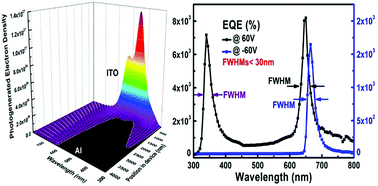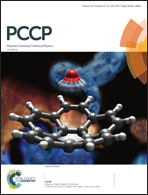Photomultiplication type narrowband organic photodetectors working at forward and reverse bias†
Abstract
It is a great challenge to obtain narrowband and photomultiplication (PM) type organic photodetectors (OPDs) without optical filters due to the broad absorption range and large exciton binding energy of organic materials. Narrowband OPDs with the special structure of ITO/PFN-OX/P3HT : PC61BM (100 : 1,wt/wt)/Al were successfully fabricated with different active layer thicknesses, exhibiting a tunable response window and PM phenomenon under bi-directional bias. The OPDs exhibit U-shaped EQE spectra with two narrowband response windows under forward bias and a single narrowband response window under reverse bias. The best EQE of the optimized OPDs with a 4.0 μm thick active layer approaches 7160% or 8180% for 340 nm or 650 nm light illumination at 60 V and 1640% for 665 nm light illumination at −60 V, respectively. The most important features of the optimized OPDs is that the full width at half-maximum (FWHM) of their response windows is less than 30 nm under bi-directional biases, which can be well maintained at large bias. The PM type narrowband OPDs working at bi-directional bias are the first to be reported with a tunable response range, further indicating that the density of the electrons trapped in PC61BM near the hole injection electrode plays the key role in determining the interfacial band bending for hole tunneling injection from the external circuit.



 Please wait while we load your content...
Please wait while we load your content...